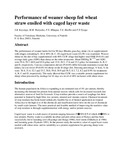| dc.description.abstract | The performance of weaner lambs fed for 90 days Rhodes grass hay alone (A) or supplemented with silages containing 0, 20 or 40% (B, C, D) caged layer waste (CLW) was examined. Weaver sheep on the diet of hay supplemented with 40% CLW silage had higher total DMI (P<0.01) and average daily gain (ADG) than sheep on the other treatments. Mean DMI/kg W 0.75 and ADG were 59.4, 58.7, 60.0 and 65.0 g/day and 15.0, 20.5, 17.6 and 33.2 g/day for treatments A, B, C and D, respectively. Carcass composition did not (P>0.05) differ between treatments except that kidney fat was lower (P<0.05) for sheep on the B silage diet. Dressing percentage, % lean, % fat were: 30.4, 31.4, 32.1 and 33.5, 58.0, 59.0, 58.9 and 58:5, 8.3, 7.2, 8.2 and 8.9% for treatments A, B, C and D, respectively. The study showed that CLW was a suitable protein supplement for sheep when processed by ensilage for 42 days at a level of 40% inclusion with wheat straw. | en |

